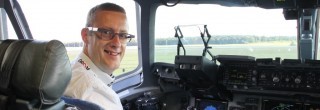Extreme weather no objection for Soyuz
 Circumstances at Baikonur were perfect when cosmonaut André Kuipers was launched into space last December: Temperatures around -30 degrees Centigrade and crystal clear skies. Why do the Russians continue using their remote base in the middle of Kazachstan’s endless steppe?
Circumstances at Baikonur were perfect when cosmonaut André Kuipers was launched into space last December: Temperatures around -30 degrees Centigrade and crystal clear skies. Why do the Russians continue using their remote base in the middle of Kazachstan’s endless steppe?
In extreme cold conditions Dutch astronaut André Kuipers and two of his colleagues were launched to the international space station ISS a few weeks ago. Since the end of the American space shuttle program, manned launches are the exclusive domain of Russian Space Agency Roscosmos. For this purpose the Russians use Soyuz rockets, which are launched from Baikonur Cosmodrome in Kazachstan. Since Kazach independence Russia leases this remote place, basically making it a Russian enclave.
Closer to the equator
The cosmodrome was secretly built in the 1950′s. In 1957 the first ever satellite Sputnik 1 was launched from here. And in 1961 Vostok 1 took off from here, carrying the first man in space Yuri Gagarin. The Russians continue using Baikonur because of its relative southerly location, at 45 degrees latitude. Further south than any location in Russia itself. The closer to the equator a rocket is launched, the more payload can be carried into space. Earth orbital speed is highest at the equator, giving a rocket maximum initial speed, requiring less fuel to get to orbital velocity.
Extreme continental climate
Baikonur is situated in the middle of a vast flat steppe, far away from any major populated area. This location has an extreme continental climate. Hot summers and cold winters, with little precipitation year round. Kuipers’ launch took place on the first day of winter, on 21 December 2011. Even for local standards this was an extreme cold day. Under a clear blue sky temperatures during the day did not raise above -20ºC. And during the launch itself, that took place about an hour after sunset, temperature had dropped to around -30ºC. Although the wind at the open plains was a moderate windforce 2 or 3, this little wind caused a windchill of around -40ºC. No pleasant working conditions. No pleasant conditions either for launching a high-tech machine with thousands of sensitive parts into space.
Russian launch criteria
An American space shuttle launch was always subject to strict weather criteria. In case of lightning within 20 nautical miles of the launch pad, any precipitation at the pad, temperatures below 5ºC or above 37ºC or wind speeds peaking over 30 nautical miles, the launch would be scrubbed. Frost conditions the night before the launch was one of the causes of the Challenger disaster in 1986. Because of this NASA applied very strict launch criteria and launches were frequently postponed.
This situation is incomparable to Russian launch criteria. This became even more obvious at the second last manned Soyuz launch. On 14 November 2011 three cosmonauts were launched from Baikonur in a heavy snow storm. On videos of this launch, the rocket is barely visible in the thick drifting snow. The launch went without any problems.
Without a hitch
The launch of Kuipers and his colleagues, five weeks later, under clear skies at -30ºC, also went without a hitch. On the exact planned second the engines ignited and the rocket accellerated towards the space station.
Official Roscosmos weather criteria for manned launches are temperatures between -40ºC and +50ºC and wind speeds below 15 meters per second (windforce 7). The Russians completely trust their Soyuz launch system. Since Sputnik there have been over 1700 launches of the different varieties of this rocket model. The Russians have not lost a single crew member during missions since 1971.
Translation from Dutch by original author of article, published in Dutch weather magazine ‘Weer Magazine’ (Volume 13, issue 1, Feb/Mar 2012)


People are over-reacting. It’s not like there can be some major flaw inherent in the rckoet’s design or the manufacturing and operating procedures, it’s been flying for what 30+ years and is it 700 or 1700 missions with a failure rate so low it’s almost certain to succeed? In space flight stuff happens sometimes, it’s probably safer to fly on a Soyuz than drive in a car or fly in a plane.You’re right, it is a short time, but the problem must be very minor and rare?Like some freak defect in an O-ring or something, easily fixed, back to normal.